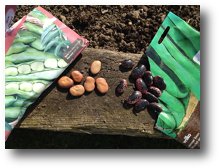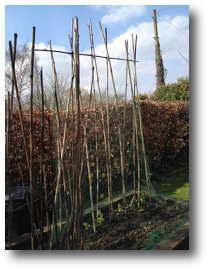Year 3-4 Areas of rectangles.
A gardener has a veg patch 20m2. The veg patch is a rectangle. How many different shapes could it be?Draw as many different possible rectangles as you can with an area of 20m2. Use 1cm2 paper.
An extra challenge
Starting with 1m2 and going as far as you can - perhaps to 30m2, how many different rectangles and squares can you find for each number? Draw the shapes for each. Don't forget you can include squares - they are special rectangles.
Year 5-6 Area and percentages
Design a vegetable garden using the following information.
• Area of vegetable garden: 600m2 • The garden is divided up so that:
• Shape of vegetable garden: rectangle
Use 1cm2 paper. Draw a scale plan of your garden. Calculate the area of the garden taken up by each type of vegetable.
Planning the vegetable garden
• What is the length and width of the garden? What is the area?
• Make a plan of your garden - what will your scale be? Try 1m of garden to 10cm on paper.
• How many rows can you have if they are 20 cm apart? Are your rows on the longest or shortest side of the plot?
Buying (and selling!)
• Compare prices of packets of plant seed (supermarkets online). Which are cheapest, most expensive?
• Check out the offers 2 for 3, buy 1 get 2nd half-price – which is best value?
• Hold a veg and plant sale after school. How much will you charge? What offers will you give?
• Did you make a profit? How much did the seeds cost? How much more did you make selling the plants and vegetables?
Planting out and care
• Reading and following instructions – always great if it is for a real situation.
• Calendars and time – which month are they planted? How long do they take to grow? Which week will they be ready to harvest?
• Measuring distances between rows and between plants in each row.
• How many seeds/plants in a row? How many in 10 rows? How many rows can you get from 1 packet of seed?
• Write a timetable/plan for watering.
• Record the weather and decide on care for cold nights and hot days.
As the plants grow
• Keep records - collect data on growth and present it on charts and graphs.
• Have a Plant Race – which are the top 10 growers each week? Which plants change position in the top 10?
• Bring in some science – compare the difference in growth between plants that have been given different amounts of water, light or kept at different temperatures.
• What is the length and width of the garden? What is the area?
• Make a plan of your garden - what will your scale be? Try 1m of garden to 10cm on paper.
• How many rows can you have if they are 20 cm apart? Are your rows on the longest or shortest side of the plot?
Buying (and selling!)
• Compare prices of packets of plant seed (supermarkets online). Which are cheapest, most expensive?
• Check out the offers 2 for 3, buy 1 get 2nd half-price – which is best value?
• Hold a veg and plant sale after school. How much will you charge? What offers will you give?
• Did you make a profit? How much did the seeds cost? How much more did you make selling the plants and vegetables?
Planting out and care
• Reading and following instructions – always great if it is for a real situation.
• Calendars and time – which month are they planted? How long do they take to grow? Which week will they be ready to harvest?
• Measuring distances between rows and between plants in each row.
• How many seeds/plants in a row? How many in 10 rows? How many rows can you get from 1 packet of seed?
• Write a timetable/plan for watering.
• Record the weather and decide on care for cold nights and hot days.
As the plants grow
• Keep records - collect data on growth and present it on charts and graphs.
• Have a Plant Race – which are the top 10 growers each week? Which plants change position in the top 10?
• Bring in some science – compare the difference in growth between plants that have been given different amounts of water, light or kept at different temperatures.
The secret with children is spreading out the growing. These are a few of my favourites which can be harvested this term.
Mustard or Cress – grow indoors for quick results. The roots can be seen within days and leaves eaten within 10 days. This is also obviously perfect for science experiments - water/no water, light/no light.
Pak Choi – the first leaves can be used in three weeks. Cut about 2-3cm from the ground and they will re-sprout. You could leave one row to harvest later.
Lettuces – lots of varieties. Sow the seeds in trays and keep indoors until they have 5-6 leaves then plant them in rows outdoors. You can keep some indoors too. Plant one row to use as baby leaves and another to leave until they are fully grown. Loose leaf varieties will be ready after about 7 weeks and solid headed lettuces by the end of this term.
Spinach - sow in rows outdoors and leaves can be cut from 5 weeks later, you can cut a few each week to the end of term.
The following have larger seeds and are easier to plant - and easier to count!
Potatoes – sow both an early and late variety. Dig up the early crop in the last week of this term and the late crop when you return in September.
Courgettes – plant outdoors and you can eat a few of the flowers (delicious on pizza) as well as pick courgettes in about 8 weeks.
Runner beans – great to watch grow and for collecting data and presenting in height charts. However harvesting will be during the summer holidays. Great for KS1 and linking it to Jack and the Beanstalk.
French beans - not as exciting to watch grow as runner beans but you will get beans by July.
Pumpkins are exciting to grow – and although you’ll see small pumpkins by the end of July leave them until the Autumn term ready for Halloween.
Watermelons and Cantaloupe need a very warm sunny position (or cover) but you can get small melons by July. Officially a vegetable but to most of us feel like a fruit – it’s a nice addition to the other vegetables.
Mustard or Cress – grow indoors for quick results. The roots can be seen within days and leaves eaten within 10 days. This is also obviously perfect for science experiments - water/no water, light/no light.
Pak Choi – the first leaves can be used in three weeks. Cut about 2-3cm from the ground and they will re-sprout. You could leave one row to harvest later.
Lettuces – lots of varieties. Sow the seeds in trays and keep indoors until they have 5-6 leaves then plant them in rows outdoors. You can keep some indoors too. Plant one row to use as baby leaves and another to leave until they are fully grown. Loose leaf varieties will be ready after about 7 weeks and solid headed lettuces by the end of this term.
Spinach - sow in rows outdoors and leaves can be cut from 5 weeks later, you can cut a few each week to the end of term.
The following have larger seeds and are easier to plant - and easier to count!
Potatoes – sow both an early and late variety. Dig up the early crop in the last week of this term and the late crop when you return in September.
Courgettes – plant outdoors and you can eat a few of the flowers (delicious on pizza) as well as pick courgettes in about 8 weeks.
Runner beans – great to watch grow and for collecting data and presenting in height charts. However harvesting will be during the summer holidays. Great for KS1 and linking it to Jack and the Beanstalk.
French beans - not as exciting to watch grow as runner beans but you will get beans by July.
Pumpkins are exciting to grow – and although you’ll see small pumpkins by the end of July leave them until the Autumn term ready for Halloween.
Watermelons and Cantaloupe need a very warm sunny position (or cover) but you can get small melons by July. Officially a vegetable but to most of us feel like a fruit – it’s a nice addition to the other vegetables.
Related articles
Teaching maths in context - using a load of potatoes
Maths ideas for each year group and a look at how a school approached it
Maths in a weather theme - which month has most rain
Rounding, ordering and comparing numbers, finding averages, and using data handling
Planning maths to include problem solving
Adapting maths problems to fit different themes
Broadbent Maths Planning Menu - User schools
Counting pollen
Estimating and counting accurately up to 150. A real-life context, good for linking to science, spring or summer and integrating data handling.
Teaching maths in context - using a load of potatoes
Maths ideas for each year group and a look at how a school approached it
Maths in a weather theme - which month has most rain
Rounding, ordering and comparing numbers, finding averages, and using data handling
Planning maths to include problem solving
Adapting maths problems to fit different themes
Broadbent Maths Planning Menu - User schools
Counting pollen
Estimating and counting accurately up to 150. A real-life context, good for linking to science, spring or summer and integrating data handling.




